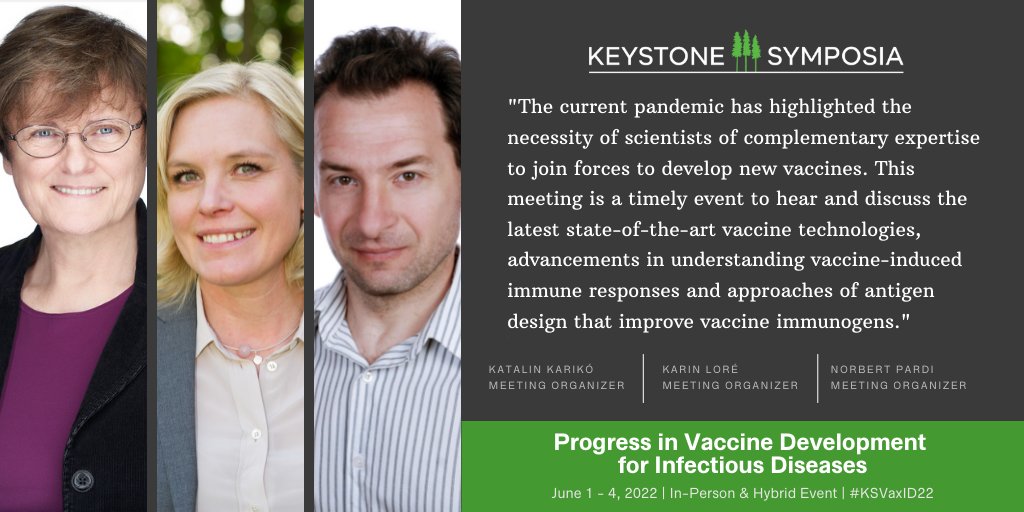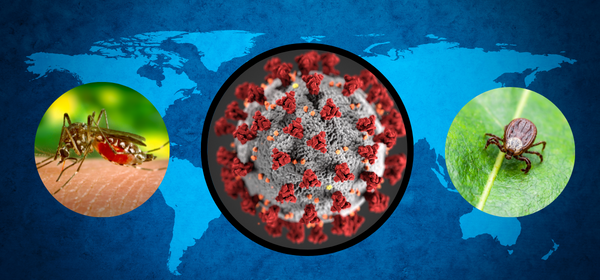KSQA with Dr. Barney Graham on COVID Vaccine Development and Upcoming Keynote Address
The upcoming Keystone Symposia, “Progress in Vaccine Development for Infectious Diseases,” will explore recent advances in vaccine technologies and design, which enabled the unprecedented and rapid success of COVID-mRNA vaccines. Keynote Speaker Dr. Barney S. Graham, former Deputy Director of the Vaccine Research Center (VRC) at the National Institutes of Allergy and Infectious Disease (NIAID), will kick off the event with insights from the front lines of the pandemic response. Spearheading the government's collaboration with Moderna to develop the first mRNA vaccine against SARS-CoV2, Dr. Graham will provide perspective on the challenges and solutions behind this incredible success story.
Here we catch up with Dr. Graham in an exclusive KSQA about the race for the COVID vaccine and pandemic preparedness efforts-- looking back and planning for the future.
Register Now to meet Dr. Graham in-person at the conference!
Watch the Full Length Interview HERE
A Career in Structure-Based Vaccine Design and Pandemic Preparedness
Dr. Barney S. Graham has recently retired after a long career spent working on respiratory viruses, primarily respiratory syncytial virus (RSV). His lab was specifically interested in structural biology, a field which can provide crucial information for vaccinology purposes. But he didn’t always think he would be working in basic science. “My career has had a lot of twists and turns,” says Dr. Graham. “I started out going to medical school, planning to be a small-town doctor, and after residency I decided to do an ID [infectious disease] fellowship. I did some chief residences, and then I got a PhD. I progressively tried to engage more and more in basic research.”
When the opportunity to work at the Vaccine Research Center (VRC), presented itself, he thought he'd give it a shot. At the time the VRC was a new entity being built on the NIH campus, with the mission to develop an Human Immunodeficiency Virus (HIV) vaccine. Graham's initial role was to develop the new vaccine evaluation clinic. But in his research lab he continued to work on viral pathogenesis and vaccine development, and in his last eight years at the VRC left the clinic to focus entirely on laboratory work.
Science is a career that you can't really entirely plan or predict. I think the best advice is that you just have to keep focusing in on the biology and asking better and better questions with better and better technology… Almost all of my work in science has been done somewhat opportunistically, by noticing technologies that were emerging in other fields that I could apply to respiratory syncytial virus pathogenesis work," says Graham.
At the Vaccine Research Center, a major component of Graham's work involved structure-based vaccine design, in an effort to develop an HIV vaccine based on the structure of the envelope glycoprotein. Structural information can answer a lot of questions about how to design vaccines against a virus, by revealing which parts of a viral protein are exposed and can therefore be targeted by immune responses.
“We've become so spoiled—once you understand and can see the atomic level structure of protein, and know how to define precisely the epitope targets of the antigenic binding sites that are needed to actually make an immune response effective. Once you have that, you don't want to go back. You always want to have structure. For me it would be very hard to start any kind of new vaccine development program without knowing the structure," says Graham.
Prior to the pandemic, Graham had already been applying structure-based vaccine design strategies against coronaviruses, motivated by the outbreaks of SARS-CoV-1 and MERS-CoV in the early 2000s as likely pandemic threats. “It was not easy to get the first coronavirus structure,” says Dr. Graham. “It took more than two years, because trying it with the MERS and the original SARS-CoV-1 coronavirus Spike proteins didn't work out. They were too unstable—we could never get a uniform structure.” It wasn't until they turned to the endemic coronavirus HKU1, a virus that causes the common cold, that they were able to finally get a structure. Part of this success was based on a structure stabilizing technique that was universally applicable across different coronaviruses. The other part was persistence. "Science is a series of failures, leading up to a breakthrough," he says.
"Once we had ways of stabilizing the structure of the spike protein, we had a generalizable approach that seemed to be working across the other members of the coronavirus family. That was part of our pandemic preparedness program, and that gave us the opportunity to rapidly solve the structure in the new coronavirus—once we had the sequence,” says Graham.
When SARS-CoV-2 emerged in China in 2019, the VRC saw the opportunity to launch a 'demonstration project' as part of their pandemic preparedness program, testing out these new techniques in a real-case scenario.
We felt like our job with the VRC was to get ready. We didn't expect (the pandemic), we didn't want it, but… there are a number of new advances over the last 10 or 15 years that really are transforming the way we can do vaccinology, and because of that, we wanted to find generalizable techniques to deploy in case of future pandemics.”
Expecting an outbreak similar to SARS-CoV-1, they partnered with Moderna to use their coronavirus stabilization technique as the foundation for structure-based mRNA vaccine design. “Our initial goal was to do a demonstration project to show what was feasible. Our plan was to go as fast as we could, whether it was a pandemic or not. We did that and it turned out that over those next eight to 12 weeks the pandemic did emerge.” Thus their demonstration project became the widespread roll-out of the Moderna mRNA vaccine, which indeed was accomplished in record breaking time. Their efficacy was an unexpected bonus, providing the world with powerful weapons to wield against a deadly virus and a devastating pandemic.
Reflecting on the experience, Graham says that in many ways we were lucky, warning that we may not get so lucky again: “I think one thing we learned during this pandemic is that talking about a problem or talking about a future catastrophe is not the same as responding to a catastrophe. Really, as much as we have discussed and talked and planned, we were not really ready for a pandemic.”
Dr. Graham believes that what will make the biggest difference for a successful future pandemic response is trust. “The thing that we need the most is trust,” says Dr. Graham. “Trust between individuals and large institutions, trust between people and their governments, trust between people and biomedical enterprises. It cannot be done quickly. So we have to do trust building and education when it's not in the middle of a crisis.”
Hear Dr. Graham's Keynote Address at the Upcoming Keystone Symposia "Progress in Vaccine Development for Infectious Disease"
About the Author
Alison Gilchrist
I graduated with my doctorate in molecular, cellular, and developmental biology from the University of Colorado Boulder in December 2020. During my PhD I studied flaviviruses, which is a group of viruses that includes dengue, Zika, and yellow fever viruses, among others. Then I moved to New York University to study the COVID-19 vaccines and our immune response to new vaccine platforms.
Throughout 2020 and into 2021, working with Keystone kept me involved in the scientific community beyond my thesis work and immediate lab surroundings, which I very much appreciated, since travel and in-person meetings were out of the question!
Every virtual meeting has taught me about new techniques and scientific discoveries, and it has been a treat to see so many possibilities on the future just as I was making decisions for my own scientific career.
Connect with Alison on Twitter @AlisonAbridged or email alison.r.gilchrist@gmail.com
See Alison’s podcasts on @BuffsTalkSci or buffstalkscience.com
Related news
Michelson Awards Luncheon Features Rising Stars in Vaccinology & Immunology
On Friday June 3, as part of the Progress in Vaccine Development for Infectious Diseases Keystone...
Climate Change & Infectious Disease Threats ePanel ON DEMAND
As climate change alters temperatures, precipitation patterns and other habitat features around the...






